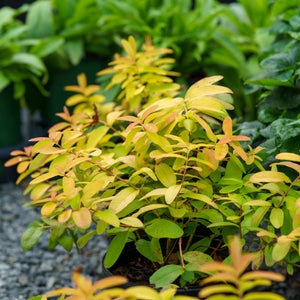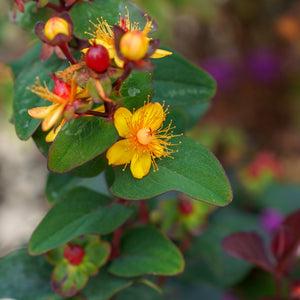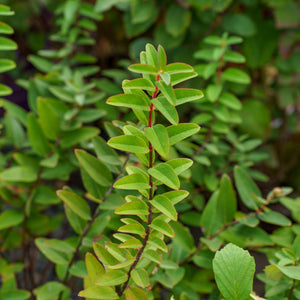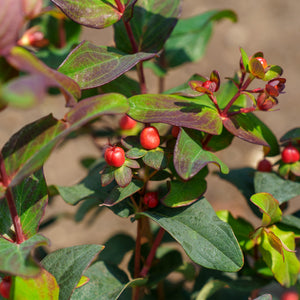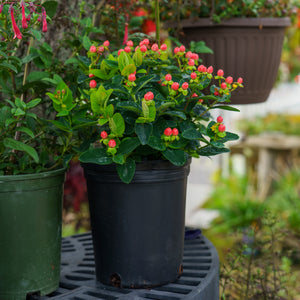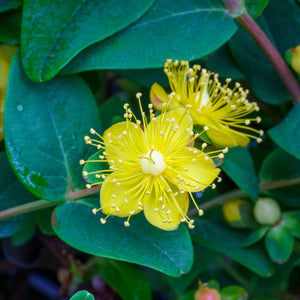The Hypericum Guide
Hypericum, commonly known as St. John’s Wort, is a versatile genus of shrubs and perennials admired for their vibrant yellow flowers and, in some varieties, colorful ornamental berries. Flowering from early summer into fall, hypericum adds multi-season interest to landscapes with its dense foliage, bright blooms, and decorative fruit clusters. Whether used in borders, mass plantings, or containers, hypericum is a durable and adaptable addition to sunny landscapes.
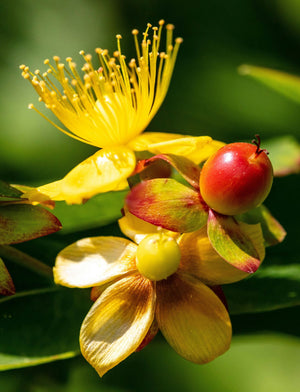
About
Hypericum includes over 400 species, ranging from low-growing groundcovers to upright, multi-stemmed shrubs. Native to temperate regions across the globe, they are widely appreciated for their ornamental value and resilience.
- Shrubby types like Hypericum frondosum 'Sunburst' and Hypericum kalmianum 'Gemo' feature golden-yellow blooms with prominent stamens and a mounding habit.
- Groundcover selections such as Hypericum calycinum spread rapidly and provide effective erosion control.
- Ornamental berry-producing types like Hypericum x inodorum 'Magical Midnight Glow', 'Miracle Pistache', and 'Pumpkin' offer striking fall and winter interest.
- Colorful cultivars like 'Albury Purple' have bronzy to purple-tinted foliage, enhancing visual contrast throughout the season.
These plants are not only aesthetically valuable but also provide habitat support for pollinators while remaining largely unbothered by browsing animals.
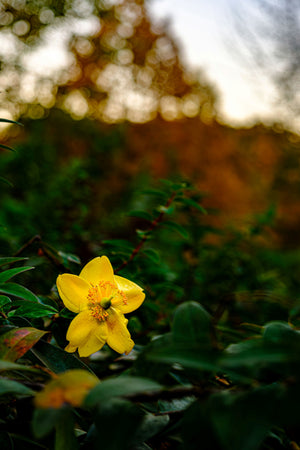
PLANTING
Hypericum is relatively easy to plant and thrives in a range of soil and climate conditions:
- USDA Hardiness Zones: Most varieties are hardy in Zones 5–9, though some can tolerate colder climates.
- Soil: Tolerates poor soils but prefers moderately fertile, well-drained soil. Avoid heavy clay or poorly drained conditions.
- Sunlight: Full sun to partial shade. Best flowering and berry production occur in full sun.
- Spacing: Space shrubs 2 to 4 feet apart, depending on mature size.
- Planting Time: Plant in spring or fall when temperatures are moderate and rainfall is more consistent.
Dig a hole twice as wide and as deep as the root ball, place the plant at soil level, backfill with amended soil, and water thoroughly. Apply mulch around the base to retain moisture and reduce weed competition.

CARE
Once established, hypericum requires minimal maintenance to thrive and remain attractive year after year:
- Watering: Water regularly during the first growing season to establish roots. Once established, most varieties are drought tolerant.
- Fertilizing: Feed lightly with a balanced slow-release fertilizer in early spring. Over-fertilizing may lead to excessive foliage growth at the expense of blooms.
- Pruning: Prune in late winter or early spring to maintain shape and encourage new growth. Shrubby types can be cut back by up to one-third.
- Pests & Diseases: Generally pest- and disease-free. Overly wet conditions can cause root rot or fungal issues.
- Mulching: A 2-3 inch layer of mulch helps regulate soil temperature and retain moisture through summer.
With routine pruning and occasional feeding, hypericum continues to flower reliably and maintain its dense form.
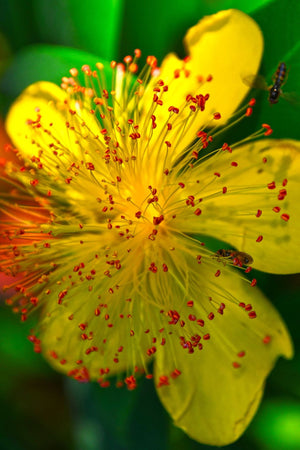
HOW TO USE
Hypericum's multi-season appeal makes it a valuable component in both formal and naturalistic plantings:
- Shrub Borders & Hedges: Use varieties like 'Sunburst' or 'Gemo' to add color, structure, and texture.
- Pollinator Gardens: Bright blooms attract bees and butterflies, making it ideal for wildlife-friendly spaces.
- Foundation Plantings: Compact forms such as 'KOLPINOT' or 'Miracle Primo' fit well around buildings and patios.
- Mass Plantings: Create uniform, low-maintenance sweeps with Hypericum calycinum or 'Deppe' for erosion control and weed suppression.
- Fall & Winter Interest: Berry-producing varieties such as 'Magical Midnight Glow' and 'Miracle Grandeur' add seasonal interest and are often used in floral arrangements.
Pair hypericum with lavender, salvia, ornamental grasses, or rudbeckia to create layered plantings with a mix of textures and bloom times.
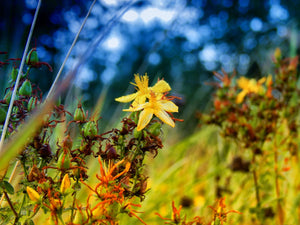
COMMON QUESTIONS
- Are hypericum berries edible? While some species have been used medicinally, most ornamental hypericum berries are not considered edible and may cause mild toxicity if consumed.
- Is hypericum toxic to dogs? Mildly toxic if ingested in large amounts. May cause digestive upset.
- Is hypericum toxic to cats? Yes, hypericum can be mildly toxic to cats if eaten.
- How tall does hypericum grow? Sizes vary. Groundcover forms grow 1–2 feet tall, while shrubby types can reach 3–5 feet tall and wide.
- Do deer eat hypericum? It is generally deer resistant due to its slightly bitter foliage.
- Do rabbits eat hypericum? Hypericum is typically avoided by rabbits.
- How to prune hypericum? Prune in late winter or early spring. Remove dead or damaged wood and trim to shape. Cutting back up to one-third is beneficial for most shrub forms.
Conclusion
Hypericum offers a winning combination of bright summer flowers, ornamental berries, and low-maintenance care. With a wide variety of forms and colors, it fits effortlessly into many types of garden designs—from erosion-controlling groundcovers to standout border shrubs. Resistant to deer and tolerant of drought, this adaptable plant adds resilience and multi-season charm to any sunny landscape.
The Hypericum Collection
Sold Out
Sold Out
Sold Out
Sold Out

